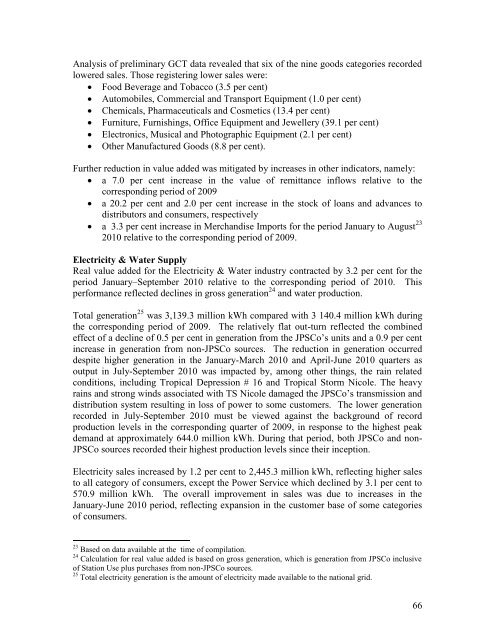PIOJ Growth-Inducement Strategy - Planning Institute of Jamaica
PIOJ Growth-Inducement Strategy - Planning Institute of Jamaica
PIOJ Growth-Inducement Strategy - Planning Institute of Jamaica
You also want an ePaper? Increase the reach of your titles
YUMPU automatically turns print PDFs into web optimized ePapers that Google loves.
Analysis <strong>of</strong> preliminary GCT data revealed that six <strong>of</strong> the nine goods categories recorded<br />
lowered sales. Those registering lower sales were:<br />
Food Beverage and Tobacco (3.5 per cent)<br />
Automobiles, Commercial and Transport Equipment (1.0 per cent)<br />
Chemicals, Pharmaceuticals and Cosmetics (13.4 per cent)<br />
Furniture, Furnishings, Office Equipment and Jewellery (39.1 per cent)<br />
Electronics, Musical and Photographic Equipment (2.1 per cent)<br />
Other Manufactured Goods (8.8 per cent).<br />
Further reduction in value added was mitigated by increases in other indicators, namely:<br />
a 7.0 per cent increase in the value <strong>of</strong> remittance inflows relative to the<br />
corresponding period <strong>of</strong> 2009<br />
a 20.2 per cent and 2.0 per cent increase in the stock <strong>of</strong> loans and advances to<br />
distributors and consumers, respectively<br />
a 3.3 per cent increase in Merchandise Imports for the period January to August 23<br />
2010 relative to the corresponding period <strong>of</strong> 2009.<br />
Electricity & Water Supply<br />
Real value added for the Electricity & Water industry contracted by 3.2 per cent for the<br />
period January–September 2010 relative to the corresponding period <strong>of</strong> 2010. This<br />
performance reflected declines in gross generation 24 and water production.<br />
Total generation 25 was 3,139.3 million kWh compared with 3 140.4 million kWh during<br />
the corresponding period <strong>of</strong> 2009. The relatively flat out-turn reflected the combined<br />
effect <strong>of</strong> a decline <strong>of</strong> 0.5 per cent in generation from the JPSCo’s units and a 0.9 per cent<br />
increase in generation from non-JPSCo sources. The reduction in generation occurred<br />
despite higher generation in the January-March 2010 and April-June 2010 quarters as<br />
output in July-September 2010 was impacted by, among other things, the rain related<br />
conditions, including Tropical Depression # 16 and Tropical Storm Nicole. The heavy<br />
rains and strong winds associated with TS Nicole damaged the JPSCo’s transmission and<br />
distribution system resulting in loss <strong>of</strong> power to some customers. The lower generation<br />
recorded in July-September 2010 must be viewed against the background <strong>of</strong> record<br />
production levels in the corresponding quarter <strong>of</strong> 2009, in response to the highest peak<br />
demand at approximately 644.0 million kWh. During that period, both JPSCo and non-<br />
JPSCo sources recorded their highest production levels since their inception.<br />
Electricity sales increased by 1.2 per cent to 2,445.3 million kWh, reflecting higher sales<br />
to all category <strong>of</strong> consumers, except the Power Service which declined by 3.1 per cent to<br />
570.9 million kWh. The overall improvement in sales was due to increases in the<br />
January-June 2010 period, reflecting expansion in the customer base <strong>of</strong> some categories<br />
<strong>of</strong> consumers.<br />
23 Based on data available at the time <strong>of</strong> compilation.<br />
24 Calculation for real value added is based on gross generation, which is generation from JPSCo inclusive<br />
<strong>of</strong> Station Use plus purchases from non-JPSCo sources.<br />
25 Total electricity generation is the amount <strong>of</strong> electricity made available to the national grid.<br />
66
















